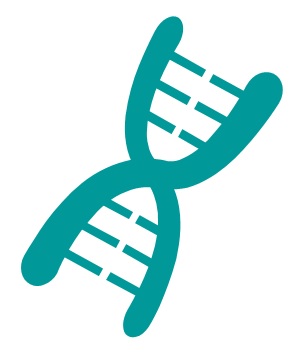SYFPEITHI MHC binding peptide
SB-PEPTIDE offers SYFPEITHI peptide for immune reactivity studies and MHC ligand assays.
Major Histocompatibility Complex (MHC)
MHC is a large cluster of genes,called Human Leukocyte Antigens (HLA) in humans and H-2 complex in mice. This DNA locus of highly polymorphic genes codes for MHC molecules,present on the cell surface,whose function is to present antigens to T-cells. Foreign antigen presentation by MHC proteins triggers the appropriate T-cells to proliferate and generate a specific cellular immune response.
The polygenism and polymorphism of MHC molecules make it difficult for pathogens to evade immune responses. This complex contains several different MHC class I and MHC class II genes to ensure that each individual has a unique set of MHC molecules capable of binding to a diverse range of peptides. MHC-I proteins are found on all nucleated cells,while MHC-II molecules are restricted to antigen-presenting cells (APCs).
MHC binding peptides
Peptides binding MHC molecules play a key role in cell-mediated immunity,as T-cells are only able to recognize foreign antigens when bound to an MHC protein. Antigenic peptide are categorized as endogenous whether they are derived from viruses,intracellular bacteria,or protozoan parasites; or as exogeneous if they originate from pathogens that replicate outside of the cell.
In order to trigger adaptive immunity towards a specific condition,peptides able to bind to all kind of MHC molecules are needed. Among these peptides,SYFPEITHI has been tested in multiple MHC ligand assays and its ability to bind both MHC class I and II molecules was demonstrated (see IEDB SYFPEITHI epitope summary).
Tyrosine Kinase (367-375) epitope – SYFPEITHI
SYFPEITHI is a linear peptide from Tyrosine-protein kinase JAK1 (UniProt: P23458) in Humans and from Tyrosine-protein kinase (UniProt: B1ASP2) and Tyrosine-protein kinase JAK1 (UniProt: P52332) in mice.
Tyrosine kinase is a cellular enzyme catalyzing the transfer of a phosphate group from ATP to a protein,according to the reaction below:
ATP + L-tyrosyl-[protein] = ADP + H+ + O-phospho-L-tyrosyl-[protein]
These proteins are important mediators to switch « on » or « off » biological processes,such as cellular growth,differentiation,metabolism and apoptosis,in response to external and internal stimuli. Among tyrosine kinases,Janus kinase 1 (JAK1) is an essential protein interacting with type I and type II cytokines,especially involved in T-cells expansion.
Epitope screening of Human and Mouse JAK1,as well as mouse Tyrosine Kinase,highlighted SYFPEITHI peptide as an interesting epitope to induce immune reactivity. The interest for MHC binding peptides stems from the growing importance for T-cells to address various diseases. Moreover,studies showed that SYFPEITHI might be used as Tumor Antigen (TA) in vaccine development to treat cancer.
For MHC binding peptides prediction,visit our related webpage to use the most appropriate database.
Technical specifications
 |
Sequence : SYFPEITHI |
 |
MW : 1106 ,23 g/mol (C53H75N11O15) |
 |
Purity : > 95% |
 |
Counter-Ion : TFA Salts (see option TFA removal) |
 |
Delivery format : Freeze dried in propylene 2mL microtubes |
 |
Peptide Solubility Guideline |
 |
Bulk peptide quantities available |
Price
| Product catalog | Size | Price € HT | Price $ USD |
| SB284-1MG | 1 mg | 165 | 206 |
References
BMC Bioinformatics. 2010 Nov 22; 11:568. doi: http://www.biomedcentral.com/1471-2105/11/568
Peptide binding predictions for HLA DR,DP and DQ molecules
Background
MHC class II binding predictions are widely used to identify epitope candidates in infectious agents,allergens,cancer and autoantigens. The vast majority of prediction algorithms for human MHC class II to date have targeted HLA molecules encoded in the DR locus. This reflects a significant gap in knowledge as HLA DP and DQ molecules are presumably equally important,and have only been studied less because they are more difficult to handle experimentally.
Results
In this study,we aimed to narrow this gap by providing a large scale dataset of over 17 ,000 HLA-peptide binding affinities for a set of 11 HLA DP and DQ alleles. We also expanded our dataset for HLA DR alleles resulting in a total of 40 ,000 MHC class II binding affinities covering 26 allelic variants. Utilizing this dataset,we generated prediction tools utilizing several machine learning algorithms and evaluated their performance.
Conclusion
We found that 1) prediction methodologies developed for HLA DR molecules perform equally well for DP or DQ molecules. 2) Prediction performances were significantly increased compared to previous reports due to the larger amounts of training data available. 3) The presence of homologous peptides between training and testing datasets should be avoided to give real-world estimates of prediction performance metrics,but the relative ranking of different predictors is largely unaffected by the presence of homologous peptides,and predictors intended for end-user applications should include all training data for maximum performance. 4) The recently developed NN-align prediction method significantly outperformed all other algorithms,including a naïve consensus based on all prediction methods. A new consensus method dropping the comparably weak ARB prediction method could outperform the NN-align method,but further research into how to best combine MHC class II binding predictions is required
J of Virology. 2010 Feb 01; 84:3. doi: https://doi.org/10.1128/jvi.02087-09
Immune Evasion Proteins of Murine Cytomegalovirus Preferentially Affect Cell Surface Display of Recently Generated Peptide Presentation Complexes
For recognition of infected cells by CD8 T cells,antigenic peptides are presented at the cell surface,bound to major histocompatibility complex class I (MHC-I) molecules. Downmodulation of cell surface MHC-I molecules is regarded as a hallmark function of cytomegalovirus-encoded immunoevasins. The molecular mechanisms by which immunoevasins interfere with the MHC-I pathway suggest,however,that this downmodulation may be secondary to an interruption of turnover replenishment and that hindrance of the vesicular transport of recently generated peptide-MHC (pMHC) complexes to the cell surface is the actual function of immunoevasins. Here we have used the model of murine cytomegalovirus (mCMV) infection to provide experimental evidence for this hypothesis. To quantitate pMHC complexes at the cell surface after infection in the presence and absence of immunoevasins,we generated the recombinant viruses mCMV-SIINFEKL and mCMV-Δm06m152-SIINFEKL,respectively,expressing the Kb-presented peptide SIINFEKL with early-phase kinetics in place of an immunodominant peptide of the viral carrier protein gp36.5/m164. The data revealed ∼10 ,000 Kb molecules presenting SIINFEKL in the absence of immunoevasins,which is an occupancy of ∼10% of all cell surface Kb molecules,whereas immunoevasins reduced this number to almost the detection limit. To selectively evaluate their effect on preexisting pMHC complexes,cells were exogenously loaded with SIINFEKL peptide shortly after infection with mCMV-SIINFEKA,in which endogenous presentation is prevented by an L174A mutation of the C-terminal MHC-I anchor residue. The data suggest that pMHC complexes present at the cell surface in advance of immunoevasin gene expression are downmodulated due to constitutive turnover in the absence of resupply.
J of Neuroscience. 2006 Feb 15;26(7):1961-1970. doi: https://doi.org/10.1523/JN€SCI.4939-05.2006
Essential Role of the Main Olfactory System in Social Recognition of Major Histocompatibility Complex Peptide Ligands
Genes of the major histocompatibility complex (MHC),which play a critical role in immune recognition,influence mating preference and other social behaviors in fish,mice,and humans via chemical signals. The cellular and molecular mechanisms by which this occurs and the nature of these chemosignals remain unclear. In contrast to the widely held view that olfactory sensory neurons (OSNs) in the main olfactory epithelium (MOE) are stimulated by volatile chemosignals only,we show here that nonvolatile immune system molecules function as olfactory cues in the mammalian MOE. Using mice with targeted deletions in selected signal transduction genes (CNGA2,CNGA4),we used a combination of dye tracing,electrophysiological,Ca2+ imaging,and behavioral approaches to demonstrate that nonvolatile MHC class I peptides activate subsets of OSNs at subnanomolar concentrations in vitro and affect social preference of male mice in vivo. Both effects depend on the cyclic nucleotide-gated (CNG) channel gene CNGA2,the function of which in the nose is unique to the main population of OSNs. Disruption of the modulatory CNGA4 channel subunit reveals a profound defect in adaptation of peptide-evoked potentials in the MOE. Because sensory neurons in the vomeronasal organ (VNO) also respond to MHC peptides but do not express CNGA2,distinct mechanisms are used by the mammalian main and accessory olfactory systems for the detection of MHC peptide ligands. These results suggest a general role for MHC peptides in chemical communication even in those vertebrates that lack a functional VNO.
J Exp Med. 2000 Jan 17;191 (2): 239–252. doi: https://doi.org/10.1084/jem.191.2.239
Cytotoxic T Lymphocyte Epitopes of HIV-1 Nef: Generation of Multiple Definitive Major Histocompatibility Complex Class I Ligands by Proteasomes
Although a pivotal role of proteasomes in the proteolytic generation of epitopes for major histocompatibility complex (MHC) class I presentation is undisputed,their precise function is currently the subject of an active debate: do proteasomes generate many epitopes in definitive form,or do they merely generate the COOH termini,whereas the definitive NH2 termini are cleaved by aminopeptidases? We determined five naturally processed MHC class I ligands derived from HIV-1 Nef. Unexpectedly,the five ligands correspond to only three cytotoxic T lymphocyte (CTL) epitopes,two of which occur in two COOH-terminal length variants. Parallel analyses of proteasomal digests of a Nef fragment encompassing the epitopes revealed that all five ligands are direct products of proteasomes. Moreover,in four of the five ligands,the NH2 termini correspond to major proteasome cleavage sites,and putative NH2-terminally extended precursor fragments were detected for only one of the five ligands. All ligands are transported by the transporter associated with antigen processing (TAP). The combined results from these five ligands provide strong evidence that many definitive MHC class I ligands are precisely cleaved at both ends by proteasomes. Additional evidence supporting this conclusion is discussed,along with contrasting results of others who propose a strong role for NH2-terminal trimming with direct proteasomal epitope generation being a rare event.
Eur J Immunol. 1998 Aug;28(8):2478-86. doi: https://doi.org/10.1002/(sici)1521-4141(199808)28:08%3C2478::aid-immu2478%3E3.0.co;2-u
The making of the dominant MHC class I ligand SYFPEITHI
The proteasome contributes to the generation of most of the peptide ligands of MHC class I molecules. To compare the identity of the peptides generated by the proteasome with those finally presented by MHC class I molecules,we generated a monoclonal antibody recognizing the C-terminal part of the dominant H2-Kd ligand SYFPEITHI derived from the JAK1 tyrosine kinase. Immunoprecipitations of lysates from H2-Kd-expressing or non-expressing cells revealed that only in the presence of H2-Kd SYFPEITHI could be isolated. No longer potential precursor peptide containing SYFPEITHI could be detected. Surprisingly,a peptide lacking the first two amino acids,FPEITHI,was isolated independently of the presence of H2-Kd molecules. The detection of only SYFPEITHI and FPEITHI in cell lysates corresponded with the strong generation of these two peptides in in vitro digests of elongated SYFPEITHI-containing peptides with purified 20S proteasomes. Our results indicate that MHC ligands can be generated directly by the proteasome in vivo and that at least for SYFPEITHI the expression of the corresponding MHC molecule is critical for protection of the ligand in vivo.
Proc. Natl. Acad. Sci. USA. 1997 Apr 01;94 (7):3262-3267. doi: https://doi.org/10.1073/pnas.94.7.3262
Cell-free tumor antigen peptide-based cancer vaccines
The central role that tumor antigen-derived peptides play in induction of antitumor immunity makes them ideal candidates for peptide-based cancer vaccines. We have demonstrated that “transloading” is an efficient strategy for importing short peptide ligands into antigen-presenting cells in vitro. Postulating that the transloading procedure might effect peptide uptake by antigen-presenting cells in vivo as well,we tested this approach for the generation of peptide-based cancer vaccines. In the P815 mastocytoma system,we vaccinated mice by s.c. injection of a single,known natural peptide derived from JAK-1 kinase. Whereas vaccination with peptide alone or mixed with incomplete Freund’s adjuvant was ineffective,application of the peptide in conjunction with the polycation poly-l-lysine protected a significant number of animals against tumor challenge. Dependent upon the type of poly-l-lysine applied,protection against tumor take was comparable to that achieved with irradiated whole-cell vaccines,genetically modified to secrete granulocyte–macrophage colony-stimulating factor. In the murine melanoma M-3,a combination of four putative tumor antigen-derived peptides was tested as a cancer vaccine. Administered in combination with polycations,these peptides evoked potent antitumor immunity that could not be obtained with the peptides alone or peptides emulsified in incomplete Freund’s adjuvant. However,peptide–polycation vaccines applied to the M-3 model were not as efficient as cellular control vaccines,consisting of irradiated interleukin 2 or granulocyte–macrophage colony-stimulating factor-secreting tumor cells.
